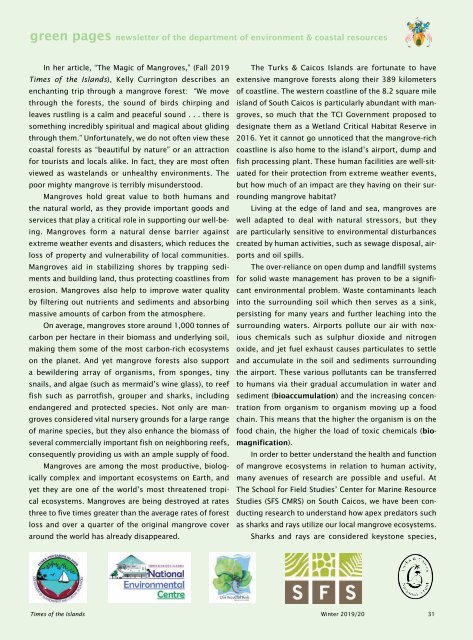Times of the Islands Winter 2019/20
Presents the "soul of the Turks & Caicos Islands" with in-depth features about local people, culture, history, environment, businesses, resorts, restaurants and activities.
Presents the "soul of the Turks & Caicos Islands" with in-depth features about local people, culture, history, environment, businesses, resorts, restaurants and activities.
You also want an ePaper? Increase the reach of your titles
YUMPU automatically turns print PDFs into web optimized ePapers that Google loves.
green pages newsletter <strong>of</strong> <strong>the</strong> department <strong>of</strong> environment & coastal resources<br />
In her article, “The Magic <strong>of</strong> Mangroves,” (Fall <strong><strong>20</strong>19</strong><br />
<strong>Times</strong> <strong>of</strong> <strong>the</strong> <strong>Islands</strong>), Kelly Currington describes an<br />
enchanting trip through a mangrove forest: “We move<br />
through <strong>the</strong> forests, <strong>the</strong> sound <strong>of</strong> birds chirping and<br />
leaves rustling is a calm and peaceful sound . . . <strong>the</strong>re is<br />
something incredibly spiritual and magical about gliding<br />
through <strong>the</strong>m.” Unfortunately, we do not <strong>of</strong>ten view <strong>the</strong>se<br />
coastal forests as “beautiful by nature” or an attraction<br />
for tourists and locals alike. In fact, <strong>the</strong>y are most <strong>of</strong>ten<br />
viewed as wastelands or unhealthy environments. The<br />
poor mighty mangrove is terribly misunderstood.<br />
Mangroves hold great value to both humans and<br />
<strong>the</strong> natural world, as <strong>the</strong>y provide important goods and<br />
services that play a critical role in supporting our well-being.<br />
Mangroves form a natural dense barrier against<br />
extreme wea<strong>the</strong>r events and disasters, which reduces <strong>the</strong><br />
loss <strong>of</strong> property and vulnerability <strong>of</strong> local communities.<br />
Mangroves aid in stabilizing shores by trapping sediments<br />
and building land, thus protecting coastlines from<br />
erosion. Mangroves also help to improve water quality<br />
by filtering out nutrients and sediments and absorbing<br />
massive amounts <strong>of</strong> carbon from <strong>the</strong> atmosphere.<br />
On average, mangroves store around 1,000 tonnes <strong>of</strong><br />
carbon per hectare in <strong>the</strong>ir biomass and underlying soil,<br />
making <strong>the</strong>m some <strong>of</strong> <strong>the</strong> most carbon-rich ecosystems<br />
on <strong>the</strong> planet. And yet mangrove forests also support<br />
a bewildering array <strong>of</strong> organisms, from sponges, tiny<br />
snails, and algae (such as mermaid’s wine glass), to reef<br />
fish such as parrotfish, grouper and sharks, including<br />
endangered and protected species. Not only are mangroves<br />
considered vital nursery grounds for a large range<br />
<strong>of</strong> marine species, but <strong>the</strong>y also enhance <strong>the</strong> biomass <strong>of</strong><br />
several commercially important fish on neighboring reefs,<br />
consequently providing us with an ample supply <strong>of</strong> food.<br />
Mangroves are among <strong>the</strong> most productive, biologically<br />
complex and important ecosystems on Earth, and<br />
yet <strong>the</strong>y are one <strong>of</strong> <strong>the</strong> world’s most threatened tropical<br />
ecosystems. Mangroves are being destroyed at rates<br />
three to five times greater than <strong>the</strong> average rates <strong>of</strong> forest<br />
loss and over a quarter <strong>of</strong> <strong>the</strong> original mangrove cover<br />
around <strong>the</strong> world has already disappeared.<br />
The Turks & Caicos <strong>Islands</strong> are fortunate to have<br />
extensive mangrove forests along <strong>the</strong>ir 389 kilometers<br />
<strong>of</strong> coastline. The western coastline <strong>of</strong> <strong>the</strong> 8.2 square mile<br />
island <strong>of</strong> South Caicos is particularly abundant with mangroves,<br />
so much that <strong>the</strong> TCI Government proposed to<br />
designate <strong>the</strong>m as a Wetland Critical Habitat Reserve in<br />
<strong>20</strong>16. Yet it cannot go unnoticed that <strong>the</strong> mangrove-rich<br />
coastline is also home to <strong>the</strong> island’s airport, dump and<br />
fish processing plant. These human facilities are well-situated<br />
for <strong>the</strong>ir protection from extreme wea<strong>the</strong>r events,<br />
but how much <strong>of</strong> an impact are <strong>the</strong>y having on <strong>the</strong>ir surrounding<br />
mangrove habitat?<br />
Living at <strong>the</strong> edge <strong>of</strong> land and sea, mangroves are<br />
well adapted to deal with natural stressors, but <strong>the</strong>y<br />
are particularly sensitive to environmental disturbances<br />
created by human activities, such as sewage disposal, airports<br />
and oil spills.<br />
The over-reliance on open dump and landfill systems<br />
for solid waste management has proven to be a significant<br />
environmental problem. Waste contaminants leach<br />
into <strong>the</strong> surrounding soil which <strong>the</strong>n serves as a sink,<br />
persisting for many years and fur<strong>the</strong>r leaching into <strong>the</strong><br />
surrounding waters. Airports pollute our air with noxious<br />
chemicals such as sulphur dioxide and nitrogen<br />
oxide, and jet fuel exhaust causes particulates to settle<br />
and accumulate in <strong>the</strong> soil and sediments surrounding<br />
<strong>the</strong> airport. These various pollutants can be transferred<br />
to humans via <strong>the</strong>ir gradual accumulation in water and<br />
sediment (bioaccumulation) and <strong>the</strong> increasing concentration<br />
from organism to organism moving up a food<br />
chain. This means that <strong>the</strong> higher <strong>the</strong> organism is on <strong>the</strong><br />
food chain, <strong>the</strong> higher <strong>the</strong> load <strong>of</strong> toxic chemicals (biomagnification).<br />
In order to better understand <strong>the</strong> health and function<br />
<strong>of</strong> mangrove ecosystems in relation to human activity,<br />
many avenues <strong>of</strong> research are possible and useful. At<br />
The School for Field Studies’ Center for Marine Resource<br />
Studies (SFS CMRS) on South Caicos, we have been conducting<br />
research to understand how apex predators such<br />
as sharks and rays utilize our local mangrove ecosystems.<br />
Sharks and rays are considered keystone species,<br />
<strong>Times</strong> <strong>of</strong> <strong>the</strong> <strong>Islands</strong> <strong>Winter</strong> <strong><strong>20</strong>19</strong>/<strong>20</strong> 31

















